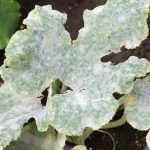Anthracnose is a fungal disease caused by Colletotrichum species although there are a number of other diseases often labelled anthracnose with similar pathology.
Crops affected:
Fruit, beans especially runner, French and dwarf beans, cucumbers. In tropical countries a number of fruits are badly affected such as mango (Dodd et al., 1997).
Symptoms:
The fungus causes patches and spots of discolouration on leaves, stems, bean pods and fruit. The affected tissue usually dies and in many cases causes severe dieback of the whole plant.
Leaf veins often develop red colours before turning brown and dying off.
Sunken brown marks appear on stems especially bean vines
Treatment:
Synthetic fungicides are used to control the disease but there is considerable interest in developing natural fruit resistance. Unfortunately, no fungicides are available to the gardener for controlling this disease.
Infected plants should be rooted out as earlier as possible.
Do not save seed.
Considerable research is now devoted to developing plants with high natural resistance. Salicylic acid production is one such antifungal agent.
References
Dodd, J.C., Prusky, D. and Jeffries, P. (1997) Fruit diseases. In: The Mango: Botany, Production and Uses (R.E. Litz, ed.) pp. 257–280, CAB International press, Wallingford, UK.


Leave a Reply